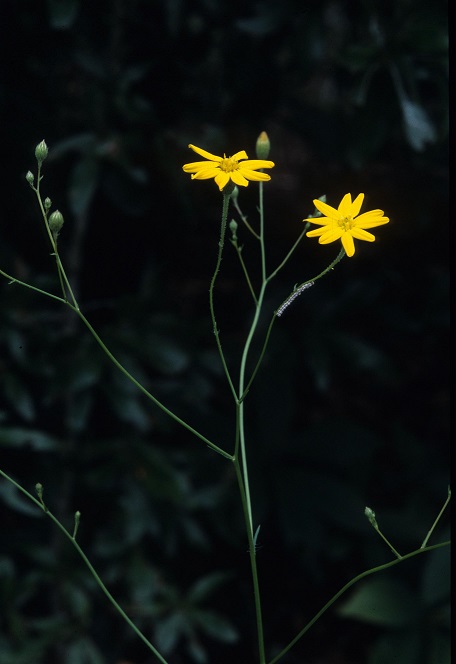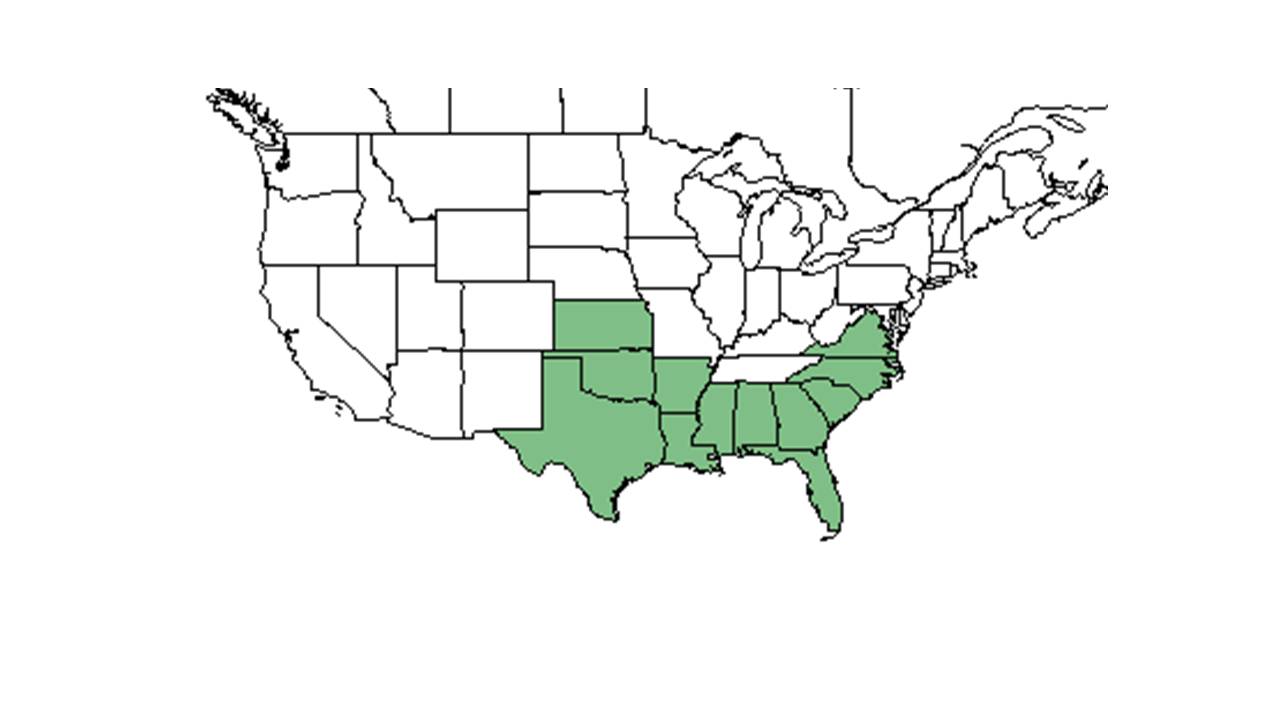Difference between revisions of "Croptilon divaricatum"
(→Ecology) |
(→Distribution) |
||
| Line 28: | Line 28: | ||
==Distribution== | ==Distribution== | ||
| − | U.S. Gulf States | + | Occurs in the U.S. Gulf States in areas that have sandy soil where pocket gophers inhabit. This gives the area the characteristic disturbed appearance, bare ground and freshly turned patches of soil. <ref name="Schaal and Leverich">Shaal, B. A., Wesley J. Leverich (1982). "Survivorship Patterns in an Annual plant community." oecologia 54(2): 149-151.</ref> It is found occasionally in disturbed areas as defined in - Analysis of Longleaf Pine Sandhill Vegetation in Northwest Florida - in the bluestem-dominant plots.<ref name=rod> Rodgers, H. L., and Louis Provencher (1999). "Analysis of Longleaf Pine Sandhill Vegetation in Northwest Florida." castanea 64(2): 138-162.</ref> |
| − | It is found occasionally in disturbed areas as defined in - Analysis of Longleaf Pine Sandhill Vegetation in Northwest Florida - in the bluestem-dominant plots.<ref>Rodgers, H. L., and Louis Provencher (1999). "Analysis of Longleaf Pine Sandhill Vegetation in Northwest Florida." castanea 64(2): 138-162.</ref> | ||
==Ecology== | ==Ecology== | ||
Revision as of 13:50, 14 April 2016
| Croptilon divaricatum | |
|---|---|

| |
| Photo was taken by Gil Nelson | |
| Scientific classification | |
| Kingdom: | Plantae |
| Division: | Magnoliophyta - Flowering plants |
| Class: | Magnoliopsida – Dicotyledons |
| Order: | Asterales |
| Family: | Asteraceae ⁄ Compositae |
| Genus: | Croptilon |
| Species: | C. divaricatum |
| Binomial name | |
| Croptilon divaricatum (Nutt.) Raf. | |

| |
| Natural range of Croptilon divaricatum from USDA NRCS Plants Database. | |
Common name: Slender scratchdaisy
Contents
Taxonomic notes
Synonyms: Haplopappus divaricatus (Nuttall) A. Gray; Isopappus divaricatus (Nuttall) Torrey & Gray;
(Inula divaricata Nuttall The Flora of North America).
Description
A description of Croptilon divaricatum is provided in The Flora of North America.
Distribution
Occurs in the U.S. Gulf States in areas that have sandy soil where pocket gophers inhabit. This gives the area the characteristic disturbed appearance, bare ground and freshly turned patches of soil. [1] It is found occasionally in disturbed areas as defined in - Analysis of Longleaf Pine Sandhill Vegetation in Northwest Florida - in the bluestem-dominant plots.[2]
Ecology
Pine thinning resulted in significantly higher frequencies of C. divaricatum after 5 and 8 years.[3]
Habitat
It occurs in Sandhill Research and Education Center in South Carolina where soil series include Lakeland sands, loamy sands. Are mostly entisols (arenic and grosarenic quartzipsamments) with high permeability and low available water capacity. Previously was an agricultural area, so some of the land includes mosaic old-fields, pine stands, scrub oak dominated forests, and forested wetlands.[4] It is found in open areas near the edges of mixed pine-hardwood forests and wetlands, at boundaries between or near 2 or more natural communities in Alachua County, Florida.[5]
It is found in longleaf pine savanna communities.[3]
It is found in Longleaf pine-wiregrass savannas, turkey oak sand ridges, and edges of hardwood swamps and hillside bogs. It is also found in human disturbed areas, such as roadsides, fallow fields, and orange groves. Requires high light levels. It is associated in areas with sandy loam, clayey soil, and sandy soil types (FSU Herbarium).
Associated species include Aster, Conyza, Lygodesmia, Liatris, Panicum, Leptoloma oognatum, and others (FSU Herbarium).
Phenology
It is a summer annual.[1] It has been observed fruiting in October and November (FSU Herbarium).
Seed dispersal
According to Kay Kirkman, a plant ecologist, this species disperses by wind. [6]
Fire ecology
It is found in frequently burned areas, such as Longleaf pine savannas (FSU Herbarium).
Use by animals
Bees were captured on Croptilon divaricatum.[5]
Conservation and Management
Cultivation and restoration
Photo Gallery
References and notes
Florida State University Robert K. Godfrey Herbarium database. URL: http://herbarium.bio.fsu.edu. Last accessed: June 2014. Collectors: Loran C. Anderson, Cecil R. Slaughter, Tara Baridi, Rex Ellis, L. Baltzell, Bruce Hansen, JoAnn Hansen, Paul L. Redfearn, Jr., C. Jackson, Robert K. Godfrey, John B. Nelson, Cortland S. Hill, A. H. Curtiss, Gary R. Knight, P. Genelle, G. Fleming, James D. Ray, Jr., Richard S. Mitchell, Andre F. Clewell, Cortland S. Hill, R. R. Smith, Gary H. Morton, Jeri Kirkland, D. B. Ward, R. Kral, Kathleen Craddock Burks, H. E. Grelen, R. A. Norris, and R. Komarek. States and Counties: Florida: Bay, Calhoun, Citrus, Clay, Dade, Dixie, Escambia, Gadsden, Hernando, Jackson, Jefferson, Lake, Leon, Liberty, Madison, Okaloosa, Putnam, Wakulla, and Walton. Georgia: Grady and Thomas.
- ↑ 1.0 1.1 Shaal, B. A., Wesley J. Leverich (1982). "Survivorship Patterns in an Annual plant community." oecologia 54(2): 149-151.
- ↑ Rodgers, H. L., and Louis Provencher (1999). "Analysis of Longleaf Pine Sandhill Vegetation in Northwest Florida." castanea 64(2): 138-162.
- ↑ 3.0 3.1 Harrington, T. B. (2011). "Overstory and understory relationships in longleaf pine plantations 14 years after thinning and woody control." Canadian Journal of Forest Research 41: 2301-2314.
- ↑ Jenkins, R. A., and Patrick D. McMillan (2009). "Vascular Flora of Sandhill Research and Education Center, Richland County, South Carolina." Castanea 74(2): 168-180.
- ↑ 5.0 5.1 Hall, H. G. a. J. S. A. (2010). "Surveys of bees (Hymenoptera: Apoidea: Anthophila) in natural areas of Alachua County in north-central Florida." The Florida Entomologist 93(4): 609-629.
- ↑ Kay Kirkman, unpublished data, 2015.